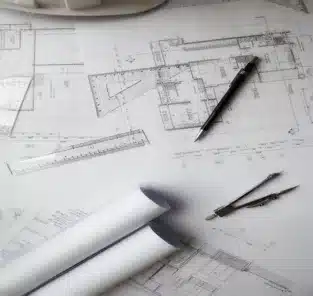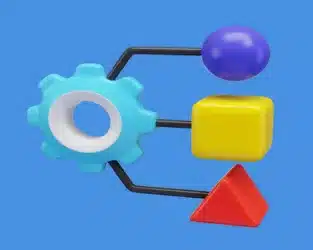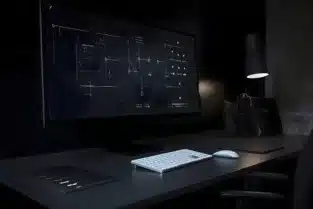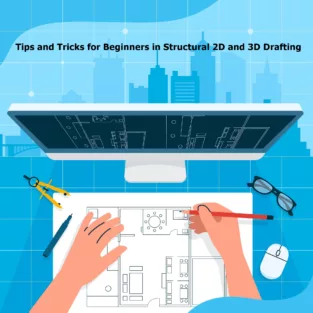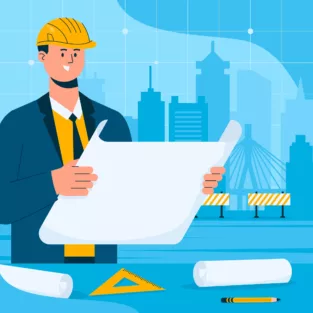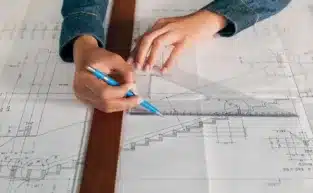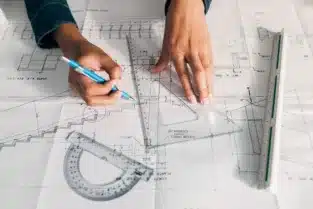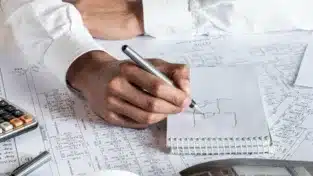Construction drawings are the backbone of any construction project. They translate the architect’s vision into a detailed plan that builders, contractors, and engineers can follow. Understanding these drawings is crucial for ensuring that a project is executed accurately and efficiently. In this guide, we’ll break down the process of understanding construction drawings, making it easier for you to navigate through the complexities of these essential documents.
Construction Drawings Tips and Tricks
1. Start with the Title Block
The title block is usually located at the bottom right corner of a construction drawing and contains key information such as the project name, drawing number, date, and scale. This is where you can find out who created the drawing and when it was last updated. The scale indicates the ratio between the drawing’s dimensions and the actual dimensions of the building, which is vital for accurate interpretation.
2. Understand the Different Types of Drawings
Construction drawings come in various forms, each serving a specific purpose. The most common types include:
- Site Plans: Show the overall layout of the construction site, including the position of the building, landscaping, roads, and utilities.
- Floor Plans: Detail the layout of each floor, showing walls, windows, doors, and other architectural elements.
- Elevation Drawings: Provide a view of the building from the outside, showing the height and external materials.
- Section Drawings: Cut through the building to show the internal structure, including walls, floors, and roofs.
- Detail Drawings: Focus on specific components or assemblies, providing a more detailed view of complex areas.
Familiarizing yourself with these types of drawings is essential to grasp the full scope of a construction project.
3. Learn the Language of Symbols and Notations
Construction drawings are filled with symbols and notations that convey important information. These symbols represent various elements like doors, windows, electrical outlets, and plumbing fixtures. Learning what these symbols mean is crucial for understanding the drawing. Additionally, notations provide details such as material specifications, dimensions, and construction methods.
Invest time in studying the legend or key that accompanies the drawings, as it will help you decode the symbols and notations used.
4. Interpreting Dimensions and Scale
Dimensions are typically indicated in feet and inches (or metric units), and they define the size and placement of objects within the drawing. Understanding how to read dimensions and scale is vital for accurate construction. The scale is particularly important when transferring the measurements from the drawing to the actual construction site. For instance, a 1:50 scale means that 1 unit on the drawing equals 50 units in reality.
Make sure to double-check dimensions and scales to ensure that everything aligns with the construction specifications.
5. Review Notes and Specifications
Construction drawings are often accompanied by notes and specifications that provide additional guidance on materials, construction techniques, and safety requirements. These notes are critical to ensuring that the project is built to the desired standards. Always review these sections thoroughly to avoid any misunderstandings during the construction process.
6. Cross-Referencing Drawings
A single construction project may involve multiple drawings that need to be cross-referenced. For example, a floor plan might need to be compared with an elevation drawing to ensure consistency in the design. Cross-referencing helps in identifying potential conflicts or discrepancies between different parts of the project. This step is crucial for coordinating various trades, such as plumbing, electrical, and HVAC, ensuring that they work together seamlessly.
7. Consulting with Professionals
If you encounter any uncertainties while interpreting construction drawings, don’t hesitate to consult with architects, engineers, or a construction drawings service. These professionals have the expertise to clarify complex details and ensure that the project is built according to the design intent.
Conclusion
Understanding construction drawings is a skill that takes time and practice to master. By following this step-by-step guide, you’ll be better equipped to interpret these vital documents, leading to smoother project execution and fewer errors on the construction site. Whether you are a builder, contractor, or project manager, having a solid grasp of construction drawings will enhance your ability to contribute to the successful completion of any project.
For more professional assistance, consider using a construction drawings service like ASTCAD to ensure that your project’s drawings are accurate, detailed, and compliant with industry standards.
How to get better at construction drawing?
Getting better at construction drawing involves a mix of developing technical skills, understanding industry standards, and practicing effective communication. Here are some steps you can take to improve your abilities:
1. Master the Basics
Learn Drafting Fundamentals: Start with a solid understanding of basic drafting techniques, including line types, scale, and the use of symbols and notations common in construction drawings.
Familiarize Yourself with CAD Software: Proficiency in computer-aided design (CAD) software is essential. Spend time mastering the tools and features of the software you use, whether it’s AutoCAD, Revit, or another platform.
2. Study Industry Standards
Understand Building Codes and Regulations: Familiarize yourself with local building codes and industry standards, such as those set by organizations like the American Institute of Architects (AIA). Knowing these standards ensures your drawings are compliant and professionally recognized.
Review Real-World Examples: Study existing construction drawings from real projects. Analyze how professionals approach different aspects of a project, such as site plans, floor plans, elevations, and sections.
3. Practice, Practice, Practice
Work on Real Projects: The best way to improve is by doing. If possible, get involved in real construction projects, even if on a small scale. Practical experience will expose you to real-world challenges and nuances that can’t be fully captured in a classroom or textbook.
Take on Complex Challenges: Don’t shy away from complicated projects. Challenging yourself with complex designs, multi-story buildings, or intricate detailing will push your skills further.
4. Enhance Your Technical Knowledge
Learn Structural and Mechanical Systems: Understanding the structural, electrical, and plumbing systems within a building will help you create more accurate and functional drawings. Consider taking courses or reading up on these topics.
Stay Updated on Technology: The field of construction drawing is constantly evolving with new technologies. Stay current with the latest software updates, tools, and best practices in drafting.
5. Improve Your Attention to Detail
Double-Check Your Work: Mistakes in construction drawings can lead to costly errors during construction. Develop a habit of reviewing your work thoroughly, checking dimensions, annotations, and consistency.
Focus on Clarity: Ensure that your drawings are clear and easy to understand. Use consistent symbols, clear labels, and maintain an organized layout to communicate your design effectively.
What makes good construction drawings?
Good construction drawings are the foundation of any successful construction project, providing clear and precise instructions that guide the construction process. Here are the key qualities that make construction drawings effective:
1. Clarity and Legibility
Clear Layout: The drawings should be organized in a logical manner, with a clean and readable layout. This includes consistent use of fonts, line weights, and symbols that are easy to understand.
Unambiguous Information: There should be no room for interpretation. All elements, from dimensions to annotations, should be straightforward and easy to read.
2. Accuracy
Precise Dimensions: Measurements must be exact, with no rounding errors. Accurate dimensions ensure that all components will fit together as planned during construction.
Correct Scale: The drawings should be to scale, and the scale should be appropriate for the level of detail required. This allows for accurate interpretation of the drawing’s elements.
3. Comprehensive Detail
Complete Information: Good construction drawings include all necessary information, such as materials, dimensions, installation details, and finishes. They should cover every aspect of the construction process.
Detailed Sections and Elevations: Including detailed sections and elevations helps to clarify complex areas of the project, providing insight into how different components interact.
